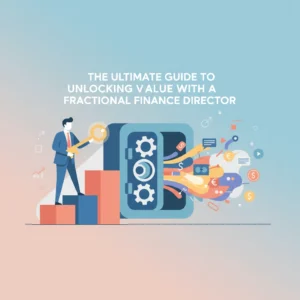If you’re running an SME and feeling like you need C-suite expertise but can’t justify the full-time salary (or the risk), you’re not alone. Welcome to the world of fractional leadership – where you get 100% of the expertise for a fraction of the cost and commitment.
Think of it as having your cake and eating it too, except the cake is a seasoned executive who knows exactly how to scale your business without breaking your budget.
What Exactly Is Fractional Leadership?
Fractional leadership isn’t just fancy consulting with a new name. It’s when experienced executives work as part-time members of your leadership team, taking real ownership of outcomes rather than just offering advice and disappearing.
Unlike traditional consultants who pop in, give recommendations, and leave you to figure out the implementation, fractional leaders roll up their sleeves and get stuck in. They’re your Chief Marketing Officer three days a week, your Chief Technology Officer for 20 hours a month, or your Chief Operations Officer during your busiest quarter.
The key difference? They’re accountable for results, not just recommendations.

The Five F’s: Why Fractional Leadership Works Brilliantly for SMEs
Focus
Fractional leaders bring laser-focused expertise to your specific challenges. No time wasted learning the ropes or figuring out your industry – they’ve been there, done that, and probably have the battle scars to prove it.
Fluency
You can handpick leaders who already speak your language, whether that’s fintech, manufacturing, or sustainable energy. They understand your world from day one, which means they can contribute immediately rather than spending months getting up to speed.
Flexibility
Need more leadership during a product launch? Scale up. Quieter period? Scale down. The fractional model adapts to your business rhythm, not the other way around. You’re never stuck with more or less leadership than you actually need.
Feasibility
Here’s where the maths gets interesting. Why pay for 2,080 hours a year of full-time leadership when you might only need 1,000 hours of focused problem-solving? You can even split those hours between different fractional leaders, creating your dream team without the dream-sized salary bill.
Fun
Fractional leaders choose their engagements carefully. They’re passionate about the projects they take on because they’re not trapped in roles that don’t excite them. This enthusiasm translates into better results for you.
Five Clear Signs Your SME Needs Fractional Leadership
1. Your CEO Is Drowning in Operations
If your chief executive is spending more time putting out fires than setting strategic direction, it’s time for backup. When operational bottlenecks are strangling growth, a fractional operations leader can provide immediate relief.
2. You’re Experiencing Growing Pains
Rapid growth is brilliant – until it isn’t. If you’re launching new products, entering new markets, or scaling faster than your current team can handle, fractional expertise can guide you through the transition without the full-time commitment.
3. You Need Specialised Skills for Specific Projects
Digital transformation? Supply chain optimisation? Sales turnaround? Some initiatives require particular expertise that your existing team might not possess. Rather than hoping for the best, bring in someone who’s done it before.
4. Your Team Is Strong but Lacks Strategic Vision
Sometimes you have brilliant people who need guidance to reach the next level. Fractional leaders often serve as mentors and coaches, implementing systems and processes that prepare your internal team for bigger challenges.
5. Budget Constraints Make Full-Time Executives Unreachable
Let’s be honest – top-tier executives command top-tier salaries. If you need C-suite expertise but full-time salaries would stretch your budget beyond comfort, fractional leadership offers a practical alternative.

Which Roles Work Best Fractionally?
Not every executive role suits the fractional model, but many do brilliantly:
Fractional Chief Marketing Officer: Perfect for companies needing strategic marketing leadership without the full-time overhead. Ideal for product launches, rebranding, or entering new markets.
Fractional Chief Technology Officer: Essential for digital transformation projects, technology strategy, or managing complex IT initiatives without hiring a full-time tech executive.
Fractional Sales Director: Brilliant for scaling sales operations, implementing new processes, or turning around underperforming sales teams.
Fractional Chief Operations Officer: Excellent for streamlining processes, managing rapid growth, or preparing for significant operational changes.
Fractional Chief Financial Officer: Ideal for companies needing financial strategy, fundraising support, or preparing for major financial transitions.
When Fractional Leadership Isn’t Right for You
Fractional leadership isn’t a magic solution for every situation. Here’s when you might want to think twice:
- You need daily, hands-on management: If your challenges require full-time, in-person leadership for day-to-day operations, fractional might not provide enough presence.
- Your team runs like clockwork: If you have strong, established leadership and smooth operations with no major changes planned, the investment might not deliver sufficient return.
- You’re not ready for change: Fractional leaders come in to shake things up and drive improvements. If you’re resistant to new approaches or processes, you won’t get the value you’re paying for.
- You need someone permanently: If the role you’re filling is genuinely a permanent, full-time requirement rather than a specific project or period of intensified need, go with a full-time hire.
Getting Started: Your Fractional Leadership Roadmap
Step 1: Define Your Needs Clearly
What specific challenges are you trying to solve? What outcomes do you want to achieve? Be as precise as possible – “improve things” isn’t helpful, but “increase sales by 30% in six months” gives everyone something to work towards.
Step 2: Choose the Right Model
Fractional engagements can be project-based, retainer-based, or equity-based. Consider your cash flow, the scope of work, and how long you’ll need support when choosing your structure.
Step 3: Set Clear Expectations
Establish communication protocols, reporting structures, and success metrics upfront. How often will they be in the office? What deliverables do you expect? How will you measure success?
Step 4: Integrate Properly
Introduce your fractional leader to the team and clarify their authority and responsibilities. They need to feel like part of the team, not an outsider looking in.

The Bottom Line: Making Fractional Leadership Work
The fractional model isn’t just a cost-saving measure – it’s a strategic approach to accessing world-class leadership expertise when and how you need it. For SMEs in 2025, it offers the perfect balance between getting the strategic guidance you need and maintaining the financial flexibility you require.
The key to success lies in choosing the right leader for your specific needs, setting clear expectations, and being open to the changes they’ll bring. Done right, fractional leadership doesn’t just solve immediate problems – it leaves your organisation stronger and more capable for whatever comes next.
Whether you’re struggling with strategic growth or need to cut leadership costs without sacrificing results, fractional leadership offers a practical, proven path forward.
Frequently Asked Questions
How much does fractional leadership cost?
Fractional leaders typically charge between £1,000-£3,000+ per day, depending on their experience and the complexity of your needs. Most engagements run 1-3 days per week or 20-60 hours per month.
How long do fractional engagements typically last?
Most fractional relationships run 6-18 months, though some project-based engagements might be shorter and some ongoing strategic roles longer.
Can I hire multiple fractional leaders?
Absolutely. Many SMEs create fractional leadership teams, combining different specialties as needed. Just ensure clear communication and defined responsibilities.
How do I know if a fractional leader is right for my company culture?
Cultural fit is crucial. Most fractional leaders offer initial consultations where you can assess compatibility. Look for someone who understands your values and communication style.
What if I decide I need someone full-time?
Many fractional relationships evolve into full-time roles if the business grows or needs change. Some fractional leaders are open to transitioning to permanent positions if it makes sense for everyone involved.


